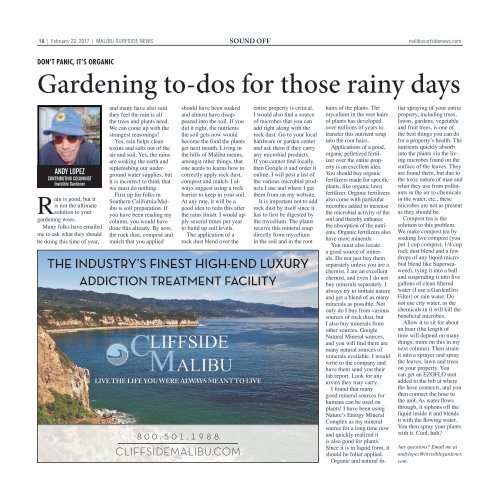MSN_022217
Malibu Surfside News 022217
Malibu Surfside News 022217
Create successful ePaper yourself
Turn your PDF publications into a flip-book with our unique Google optimized e-Paper software.
18 | February 22, 2017 | Malibu surfside news Sound Off<br />
malibusurfsidenews.com<br />
Don’t Panic, It’s Organic<br />
Gardening to-dos for those rainy days<br />
Andy Lopez<br />
Contributing Columnist<br />
Invisible Gardener<br />
Rain is good, but it<br />
is not the ultimate<br />
solution to your<br />
gardening woes.<br />
Many folks have emailed<br />
me to ask what they should<br />
be doing this time of year,<br />
and many have also said<br />
they feel the rain is all<br />
the trees and plants need.<br />
We can come up with the<br />
strangest reasonings!<br />
Yes, rain helps clean<br />
toxins and salts out of the<br />
air and soil. Yes, the rains<br />
are soaking the earth and<br />
replenishing our underground<br />
water supplies, but<br />
it is incorrect to think that<br />
we must do nothing.<br />
First up for folks in<br />
Southern California/Malibu<br />
is soil preparation. If<br />
you have been reading my<br />
column, you would have<br />
done this already. By now,<br />
the rock dust, compost and<br />
mulch that you applied<br />
should have been soaked<br />
and almost have disappeared<br />
into the soil. If you<br />
did it right, the nutrients<br />
the soil gets now would<br />
become the food the plants<br />
get next month. Living in<br />
the hills of Malibu means,<br />
amongst other things, that<br />
one needs to learns how to<br />
correctly apply rock dust,<br />
compost and mulch. I always<br />
suggest using a rock<br />
barrier to keep in your soil.<br />
At any rate, it will be a<br />
good idea to redo this after<br />
the rains finish. I would apply<br />
several times per year<br />
to build up soil levels.<br />
The application of a<br />
rock dust blend over the<br />
entire property is critical.<br />
I would also find a source<br />
of microbes that you can<br />
add right along with the<br />
rock dust. Go to your local<br />
hardware or garden center<br />
and ask them if they carry<br />
any microbial products.<br />
If you cannot find locally,<br />
then Google it and order it<br />
online. I will post a list of<br />
the various microbial products<br />
I use and where I get<br />
them from on my website.<br />
It is important not to add<br />
rock dust by itself since it<br />
has to first be digested by<br />
the mycelium. The plants<br />
receive this mineral soup<br />
directly from mycelium<br />
in the soil and in the root<br />
THE INDUSTRY’S FINEST HIGH-END LUXURY<br />
ADDICTION TREATMENT FACILITY<br />
LIVE THE LIFE YOU WERE ALWAYS MEANT TO LIVE<br />
800.501.1988<br />
CLIFFSIDEMALIBU.COM<br />
hairs of the plants. The<br />
mycelium in the root hairs<br />
of plants has developed<br />
over millions of years to<br />
transfer this nutrient soup<br />
into the root hairs.<br />
Applications of a good,<br />
organic pelletized fertilizer<br />
over the entire property<br />
is an excellent idea.<br />
You should buy organic<br />
fertilizers made for specific<br />
plants, like organic lawn<br />
fertilizer. Organic fertilizers<br />
also come with particular<br />
microbes added to increase<br />
the microbial activity of the<br />
soil and thereby enhance<br />
the absorption of the nutrients.<br />
Organic fertilizers also<br />
have more minerals.<br />
You must also locate<br />
a good source of minerals.<br />
Do not just buy them<br />
separately unless you are a<br />
chemist. I am an excellent<br />
chemist, and even I do not<br />
buy minerals separately. I<br />
always try to imitate nature<br />
and get a blend of as many<br />
minerals as possible. Not<br />
only do I buy from various<br />
sources of rock dust, but<br />
I also buy minerals from<br />
other sources. Google<br />
Natural Mineral sources,<br />
and you will find there are<br />
many natural sources of<br />
minerals available. I would<br />
write to the company and<br />
have them send you their<br />
lab report. Look for any<br />
toxins they may carry.<br />
I found that many<br />
good mineral sources for<br />
humans can be used on<br />
plants! I have been using<br />
Nature’s Energy Mineral<br />
Complex as my mineral<br />
source for a long time now<br />
and quickly realized it<br />
is also good for plants.<br />
Since it is in liquid form, it<br />
should be foliar applied.<br />
Organic and natural foliar<br />
spraying of your entire<br />
property, including trees,<br />
lawns, gardens, vegetable<br />
and fruit trees, is one of<br />
the best things you can do<br />
for a property’s health. The<br />
nutrients quickly absorb<br />
into the plants via the living<br />
microbes found on the<br />
surface of the leaves. They<br />
are found there, but due to<br />
the toxic nature of man and<br />
what they use from pollutants<br />
in the air to chemicals<br />
in the water, etc., these<br />
microbes are not as present<br />
as they should be.<br />
Compost tea is the<br />
solution to this problem.<br />
We make compost tea by<br />
soaking live compost (you<br />
put 1 cup compost, 1/4 cup<br />
rock dust blend and a few<br />
drops of any liquid microbial<br />
blend like Superseaweed),<br />
tying it into a ball<br />
and suspending it into five<br />
gallons of clean filtered<br />
water (I use a GardenGro<br />
Filter) or rain water. Do<br />
not use city water, as the<br />
chemicals in it will kill the<br />
beneficial microbes.<br />
Allow it to sit for about<br />
an hour (the length of<br />
time will depend on many<br />
things; more on this in my<br />
next column). Then strain<br />
it into a sprayer and spray<br />
the leaves, lawn and trees<br />
on your property. You<br />
can get an EZOFLO unit<br />
added to the bib at where<br />
the hose connects, and you<br />
then connect the hose to<br />
the unit. As water flows<br />
through, it siphons off the<br />
liquid inside it and blends<br />
it with the flowing water.<br />
You then spray your plants<br />
with it. Cool, huh?<br />
Any questions? Email me at<br />
andylopez@invisiblegardener.<br />
com.


















